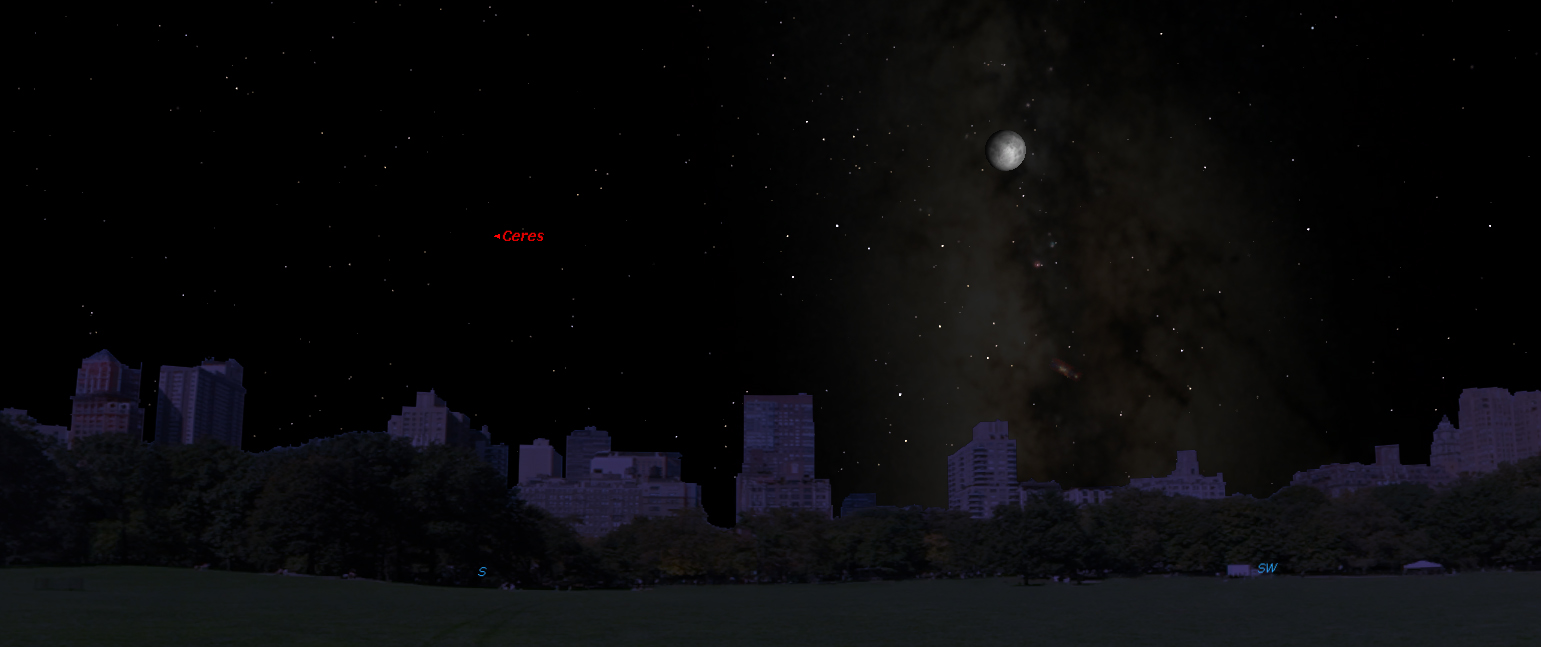Dwarf Planet Ceres Reaches Opposition in Night Sky

With all the news about Pluto this month, most skywatchers may not be aware that Ceres, the brightest and nearest of the dwarf planets, reached its opposition to the sun on Saturday (July 25).
An object is said to be in opposition when it is directly opposite the sun in Earth's sky. When an object is in opposition, it rises at sunset, is visible all night and then sets at sunrise.
When Ceres was discovered by Giuseppe Piazzi on the first day of the 19th century, Jan. 1, 1801, it was initially thought to be a planet. Other objects were soon discovered in the gap between the orbits of Mars and Jupiter, so a new name was proposed for these tiny bodies, "asteroids." This was because of their resemblance to stars in the telescopes of the day. [Amazing Photos of Ceres]
When the International Astronomical Union proposed a new category, "dwarf planet," in 2006, Ceres was included, along with Pluto, Eris, Haumea, and Makemake. So tiny Ceres has been called three different things in the 214 years since it was discovered: planet, asteroid, and now dwarf planet.
Despite its recent designation as a dwarf planet, Ceres is still considered to be an asteroid by most astronomers. As such, it is the largest of the asteroids at 592 miles (952 kilometers) in diameter, almost twice the diameter and four times the mass of the next largest asteroids, Pallas and Vesta. On the other hand, Ceres is far smaller than any of the other designated dwarf planets. It is also smaller than 15 of the moons in the solar system, including Earth's moon.
This year, Ceres reached opposition just on the Sagittarius side of the border between Sagittarius and the little-known constellation Microscopium. It is most easily found by looking within the triangle formed three 4th magnitude stars: 62 Sagittarii, the easternmost star in Sagittarius, Omega Capricorni, the southernmost star in Capricornus, and Gamma Microscopii, the brightest star in the dim constellation Microscopium, the Microscope.
Because of its faintness, magnitude 7.5 at opposition, detailed charts are needed to distinguish Ceres from the stars it's passing in front of. Our chart shows its position on the morning of opposition, Saturday, July 25. If you try to find it on any other night, you will need to plot its position with a program like Starry Night or SkySafari.
Breaking space news, the latest updates on rocket launches, skywatching events and more!
As seen in even the largest telescopes on Earth, Ceres appears as a point of light, no different than the background stars. The only way to be sure you have seen it is to plot its position and then try to observe the same area on another night.
On March 6 this year, the Dawn spacecraft entered orbit around Ceres, and has since been returning detailed images of Ceres' surface. Thus, 2015 marks a special year for the exploration of the solar system, with Dawn orbiting Ceres and New Horizons flying close to Pluto.
This article was provided to SPACE.com by Simulation Curriculum, the leader in space science curriculum solutions and the makers of Starry Night and SkySafari. Follow Starry Night on Twitter @StarryNightEdu. Follow us @Spacedotcom, Facebook and Google+. Original article on Space.com.

Geoff Gaherty was Space.com's Night Sky columnist and in partnership with Starry Night software and a dedicated amateur astronomer who sought to share the wonders of the night sky with the world. Based in Canada, Geoff studied mathematics and physics at McGill University and earned a Ph.D. in anthropology from the University of Toronto, all while pursuing a passion for the night sky and serving as an astronomy communicator. He credited a partial solar eclipse observed in 1946 (at age 5) and his 1957 sighting of the Comet Arend-Roland as a teenager for sparking his interest in amateur astronomy. In 2008, Geoff won the Chant Medal from the Royal Astronomical Society of Canada, an award given to a Canadian amateur astronomer in recognition of their lifetime achievements. Sadly, Geoff passed away July 7, 2016 due to complications from a kidney transplant, but his legacy continues at Starry Night.

